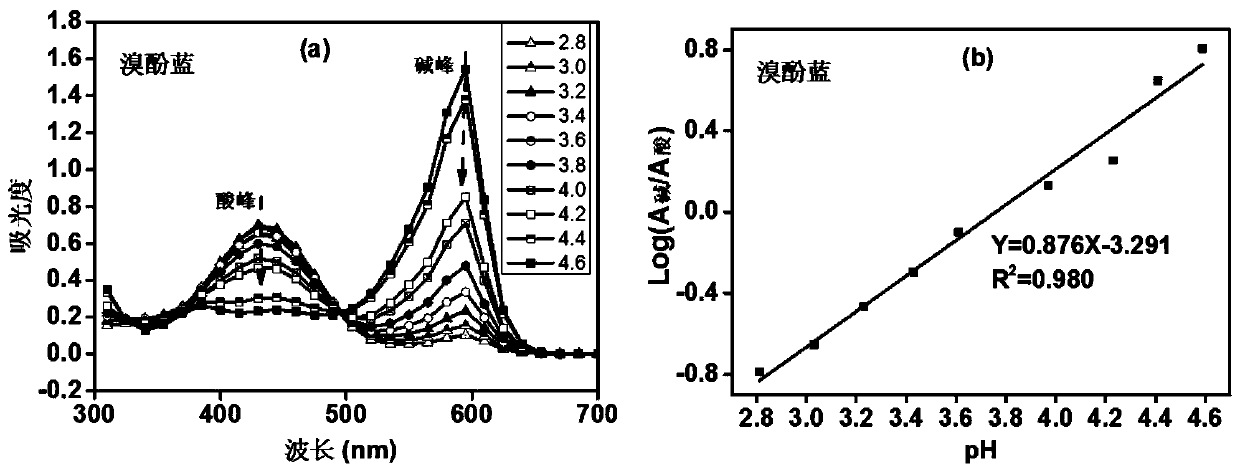A method and application of using dye indicator to test the surface pH of mineral samples
A technology of indicator and acid-base indicator, which is applied in the field of soil analysis, can solve problems such as no relevant research reports, and achieve the effect of low condition requirements, simple operation and strong adaptability
- Summary
- Abstract
- Description
- Claims
- Application Information
AI Technical Summary
Problems solved by technology
Method used
Image
Examples
Embodiment 1
[0058] 1. Solution preparation
[0059] Select six acid-base indicator dyes to form a pH range of 1.2-8.0, namely thymol blue (1.2-2.8), bromophenol blue (2.8-4.6), bromocresol green (3.8-5.4), Bromocresol purple (5.2-6.8), neutral red (6.8-7.8), phenol red (6.8-8.0). According to the working pH range of each indicator dye, add HCl (1M) and NaOH (1M) solutions dropwise to make indicator dye solutions with different pHs. The solvent is methanol / water solution with a mass ratio of 1:9, and the pH meter is used for testing.
[0060] 2. Drawing of indicator standard curve
[0061] The prepared solutions of different pH of the same indicator were added to the cuvette in turn, and the spectrum of the indicator dye solution was scanned by an ultraviolet-visible light spectrometer, with a scanning step of 1 nm and a wavelength range of 300 to 700 nm. Acid peaks (InH) and base peaks (InH) with different peak intensities at different pHs can be obtained - ) The diffuse reflectance sp...
Embodiment 2
[0069] The six acid-base indicator dyes in Example 1 were selected to form a pH variation range of 1.2 to 8.0. Select montmorillonite as the test mineral. In order to ensure that the weighed mineral samples can be completely colored, the volume-to-mass ratio (mL / g) of the solution to the mineral is optimized to 1.2, and the selected ratio of dyes is added to the mineral to make it to color. Spread it evenly with a glass rod and dry it at 40°C for 1 hour. After grinding, install it on the sample pressing plate, compact it and ensure the surface is smooth. For each experiment, the montmorillonite was treated in the same way as above with methanol aqueous solution without indicator, and it was used as a blank sample for spectral determination. The powder diffuse reflectance mode of the ultraviolet-visible light diffuse reflectance spectrometer is used to test the colored solid sample ( Figure 9 ). The standard curve equation y=0.873x-5.324( Figure 4 ), according to the acid...
Embodiment 3
[0072]The six acid-base indicator dyes in Example 1 were selected to form a pH variation range of 1.2 to 8.0. Rutile was selected as the test mineral. In order to ensure that all the mineral samples weighed can be colored, the volume-to-mass ratio (mL / g) of the solution to the mineral was optimized to 1.6, and a selected ratio of dye was added to the mineral to make it colored . Spread it evenly with a glass rod and dry it at 40°C for 1 hour. After grinding, install it on the sample pressing plate, compact it and ensure the surface is smooth. For each experiment, the mineral sample (rutile) was treated the same as above with methanol aqueous solution without indicator, and it was used as a blank sample for spectroscopic determination. The powder diffuse reflectance mode of the ultraviolet-visible light diffuse reflectance spectrometer is used to test the colored solid sample ( Figure 10 ). combined in Figure 10 The standard curve equation y=0.873x-5.324( Figure 4 ), ca...
PUM
| Property | Measurement | Unit |
|---|---|---|
| particle size | aaaaa | aaaaa |
Abstract
Description
Claims
Application Information
 Login to View More
Login to View More - R&D
- Intellectual Property
- Life Sciences
- Materials
- Tech Scout
- Unparalleled Data Quality
- Higher Quality Content
- 60% Fewer Hallucinations
Browse by: Latest US Patents, China's latest patents, Technical Efficacy Thesaurus, Application Domain, Technology Topic, Popular Technical Reports.
© 2025 PatSnap. All rights reserved.Legal|Privacy policy|Modern Slavery Act Transparency Statement|Sitemap|About US| Contact US: help@patsnap.com



